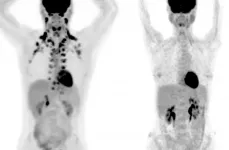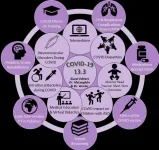(Press-News.org) Some racial and ethnic groups suffer relatively more often, and fare worse, from common ailments compared to others. Prostate cancer is one disease where such health disparities occur: risk for the disease is about 75 percent higher, and prostate cancer is more than twice as deadly, in Blacks compared to whites. Yet whites are often overrepresented as research participants, making these differences difficult to understand and, ultimately, address.
With this problem in mind, scientists at the USC Center for Genetic Epidemiology and the Institute for Cancer Research, London, led a study that brings together data from the majority of genomic prostate cancer studies globally. Including more than 200,000 men of European, African, Asian and Hispanic ancestry from around the world, the study is the largest, most diverse genetic analysis ever conducted for prostate cancer -- and possibly for any other cancer.
The paper appears today in Nature Genetics.
The study's authors identified 86 new genetic variations that increase risk for prostate cancer, not previously discovered, bringing the total number of risk loci for prostate cancer to 269. Applying a model for assessing prostate cancer risk based on the interplay of these genetic factors, the researchers showed that men of African ancestry inherit about twice the prostate cancer risk on average compared to men of European ancestry, while men of Asian ancestry inherit about three-quarter the risk of their white counterparts -- evidence that genetics play some part in the differences in how often cancer occurs in different racial groups.
This research is also a step toward applying precision medicine to early detection.
"Our long-term objective is to develop a genetic risk score that can be used to determine a man's risk of developing prostate cancer," said corresponding author Christopher Haiman, ScD, professor of preventive medicine at the Keck School of Medicine of USC and director of the USC Center for Genetic Epidemiology. "Men at higher risk may benefit from earlier and more frequent screening, so the disease can be identified when it's more treatable."
Study tackles health disparities
Praise for the study's potential in increasing health equity came from Jonathan W. Simons, MD, president and chief executive officer of the Prostate Cancer Foundation. The foundation funds Haiman's other work leading the RESPOND initiative exploring the disease among African American men.
"PCF believes that Dr. Haiman's research findings will lead to more effective prostate cancer precision screening strategies for men of West African ancestry," Simons said. "PCF is certain that identification of these very high-risk individuals will make a positive impact on this significant health care disparity."
Haiman and his colleagues used genomic datasets from countries including the U.S., the UK, Sweden, Japan, and Ghana to compare 107,247 men with prostate cancer to a control group comprising 127,006 men. By examining a spectrum of races and ethnicities, the study's authors aim to make the genetic risk score more useful for more people.
"We not only found new markers of risk, but also demonstrated that, by combining genetic information across populations, we were able to identify a risk profile that can be applied across populations," said Haiman. "This emphasizes the value of adding multiple racial and ethnic populations into genetic studies."
Risk score could contribute to better screening
Today's screening guidelines for prostate cancer suggest that those 55 and older with average risk can choose to take the prostate-specific antigen (PSA) test in consultation with their physicians. High PSA levels are associated with prostate cancer, but the PSA test tends to detect slow-growing tumors. With widespread use, it too often leads to unnecessary treatment.
The PSA test's value as a screening tool would grow if it were deployed selectively to monitor people found to be at high risk for prostate cancer -- which is where the genetic risk score could come into play. Those at particularly high risk might even begin screening before age 55.
In order to translate the current research findings into better early detection, a large-scale clinical trial would be needed.
"Most important, unlike previous screening trials, this one would need to be more representative of the diversity we see in the world," Haiman said. "No population should get left behind."
INFORMATION:
About this study
The paper has more than 230 co-authors, representing scores of organizations. Co-first authors of the study are David Conti, PhD, professor of preventive medicine, and Burcu Darst, PhD, a postdoctoral scholar and research associate, both of the Keck School of Medicine. Co-senior authors are Haiman, on behalf of the Elucidating Loci Involved in Prostate Cancer Susceptibility (ELLIPSE) consortium, and the ICR's Rosalind Eeles, FMedSci, PhD, FRCP, FRCR, and Zsofia Kote-Jarai, PhD, on behalf of the Prostate Cancer Association Group to Investigate Cancer Associated Alterations in the Genome (PRACTICAL) consortium.
This study was supported by National Institutes of Health (U19CA148537, R01CA194393, K99CA246063), with further support from Cancer Research UK, Prostate Cancer UK, and the Movember Foundation.
Last year, more than fifty years after initial theoretical proposals, researchers in Pisa, Stuttgart and Innsbruck independently succeeded for the first time in creating so-called supersolids using ultracold quantum gases of highly magnetic lanthanide atoms. This state of matter is, in a sense, solid and liquid at the same time. "Due to quantum effects, a very cold gas of atoms can spontaneously develop both a crystalline order of a solid crystal and particle flow like a superfluid quantum liquid, i.e. a fluid able to flow without any friction" explains Francesca Ferlaino from the Institute for Quantum Optics and Quantum Information of the Austrian Academy of Sciences and the Department of Experimental Physics at the ...
Research from the University of Kent's Durrell Institute of Conservation and Ecology (DICE) has found that elephant ivory is still being sold on the online marketplace eBay, despite its 10-year-old policy banning the trade in ivory.
The trafficking of wildlife over the internet continues to be a problem, with the detection of illegal activity being challenging. Despite efforts of law enforcement, the demand for illegal wildlife products online has continued to increase. In some cases vendors have adopted the use of 'code words' to disguise the sale of illicit items.
Sofia Venturini ...
PORTLAND, Ore. - Researchers at Oregon State University have found that a few organisms in the gut microbiome play a key role in type 2 diabetes, opening the door to possible probiotic treatments for a serious metabolic disease affecting roughly one in 10 Americans.
"Type 2 diabetes is in fact a global pandemic and the number of diagnoses is expected to keep rising over the next decade," said study co-leader Andrey Morgun, associate professor of pharmaceutical sciences in the OSU College of Pharmacy. "The so-called 'western diet' - high in saturated fats and refined sugars - is one of the primary factors. But gut bacteria have an important role to play in modulating the effects of diet."
Formerly known as adult-onset diabetes, type 2 diabetes is a chronic condition ...
To make kefir, it takes a team. A team of microbes.
That's the message of new research from EMBL and Cambridge University's Patil group and collaborators, published in Nature Microbiology today. Members of the group study kefir, one of the world's oldest fermented food products and increasingly considered to be a 'superfood' with many purported health benefits, including improved digestion and lower blood pressure and blood glucose levels. After studying 15 kefir samples, the researchers discovered to their surprise that the dominant species of Lactobacillus ...
CORVALLIS, Ore. - Forest loss declined 18% in African nations where a new satellite-based program provides free alerts when it detects deforestation activities.
A research collaboration that included Jennifer Alix-Garcia of Oregon State University found that the Global Land Analysis and Discovery System, known as GLAD, resulted in carbon sequestration benefits worth hundreds of millions of dollars in GLAD's first two years.
Findings were published today in Nature Climate Change.
The premise of GLAD is simple: Subscribe to the system, launch a free web application, receive email alerts when the GLAD algorithm detects deforestation going on and then take action to save forests.
GLAD, launched in 2016, delivers alerts created ...
CHAMPAIGN, Ill. -- Cities only occupy about 3% of the Earth's total land surface, but they bear the burden of the human-perceived effects of global climate change, researchers said. Global climate models are set up for big-picture analysis, leaving urban areas poorly represented. In a new study, researchers take a closer look at how climate change affects cities by using data-driven statistical models combined with traditional process-driven physical climate models.
The results of the research led by University of Illinois Urbana Champaign engineer Lei Zhao are published in the journal Nature Climate Change.
Home to more than 50% of the world's population, cities experience more heat stress, water scarcity, air pollution ...
Brown fat is that magical tissue that you would want more of. Unlike white fat, which stores calories, brown fat burns energy and scientists hope it may hold the key to new obesity treatments. But it has long been unclear whether people with ample brown fat truly enjoy better health. For one thing, it has been hard to even identify such individuals since brown fat is hidden deep inside the body.
Now, a new study in Nature Medicine offers strong evidence: among over 52,000 participants, those who had detectable brown fat were less likely than their peers to suffer cardiac and metabolic conditions ranging from type 2 diabetes to coronary artery disease, which ...
Amsterdam, NL, January 4, 2021 - The impact of the COVID-19 pandemic on children with disabilities has not received much attention, perhaps because the disease disproportionately affects older individuals. In this special issue of the Journal of Pediatric Rehabilitation Medicine experts assess the impact of the pandemic on pediatric patients with special needs, their caregivers, and healthcare providers. They also focus on the growing importance of telemedicine and provide insights and recommendations for mitigating the impact of the virus in the short and long term.
"Pediatric rehabilitation patients frequently ...
TAMPA, Fla. -- Prostate cancer is one of the most common cancers among men in the U.S. For many patients, hormone therapy is a treatment option. This type of therapy, also called androgen deprivation therapy (ADT), reduces the level of testosterone and other androgens in the body. Lowering androgen levels can make prostate cancer cells grow more slowly or shrink tumors over time. However, patients receiving ADT often experience higher levels of fatigue, depression and cognitive impairment.
Moffitt Cancer Center researchers are investigating whether inflammation ...
PROVIDENCE, R.I. [Brown University] -- Sea ice is a critical indicator of changes in the Earth's climate. A new discovery by Brown University researchers could provide scientists a new way to reconstruct sea ice abundance and distribution information from the ancient past, which could aid in understanding human-induced climate change happening now.
In a study published in Nature Communications, the researchers show that an organic molecule often found in high-latitude ocean sediments, known as tetra-unsaturated alkenone (C37:4), is produced by one or more previously unknown species of ice-dwelling algae. As sea ice concentration ebbs and flows, so do the algae associated with it, as well as the molecules ...




